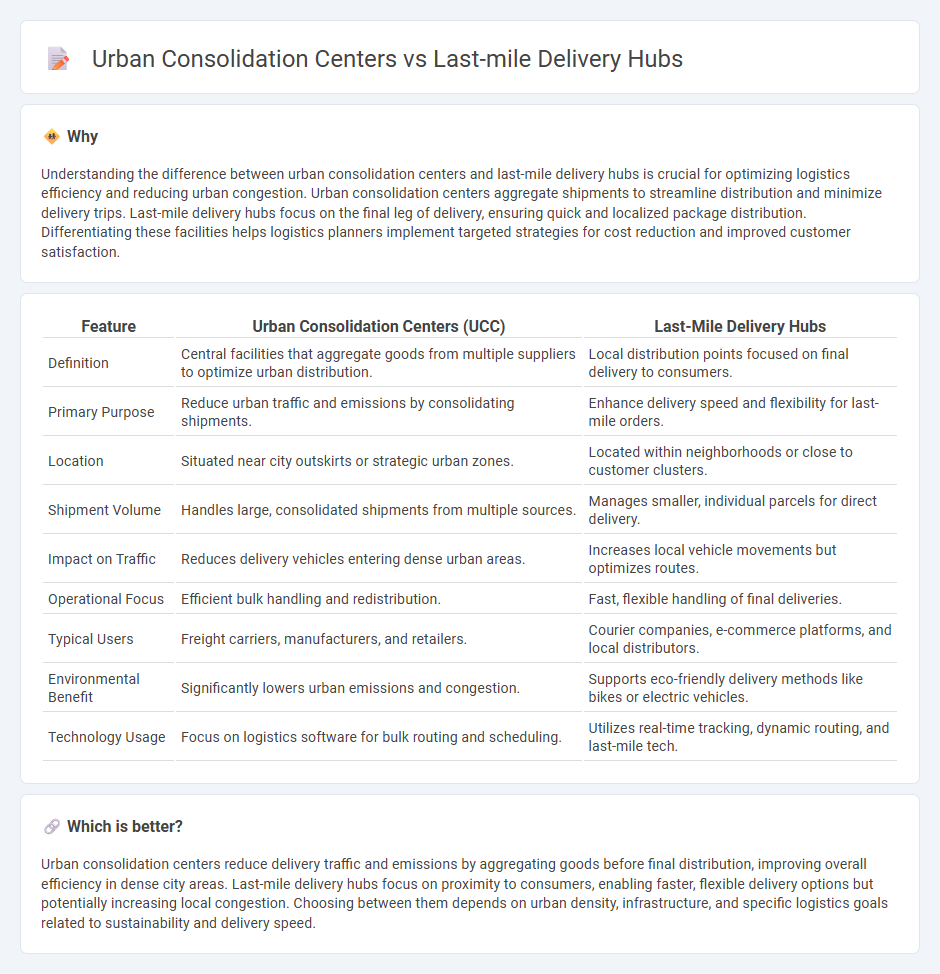
Urban consolidation centers streamline supply chains by consolidating deliveries in central locations, reducing traffic congestion and emissions in densely populated areas. Last-mile delivery hubs focus on the final segment of transportation, ensuring faster, more flexible parcel distribution directly to consumers. Explore the advantages and operational distinctions of these logistics solutions to optimize urban freight management.
Why it is important
Understanding the difference between urban consolidation centers and last-mile delivery hubs is crucial for optimizing logistics efficiency and reducing urban congestion. Urban consolidation centers aggregate shipments to streamline distribution and minimize delivery trips. Last-mile delivery hubs focus on the final leg of delivery, ensuring quick and localized package distribution. Differentiating these facilities helps logistics planners implement targeted strategies for cost reduction and improved customer satisfaction.
Comparison Table
| Feature | Urban Consolidation Centers (UCC) | Last-Mile Delivery Hubs |
|---|---|---|
| Definition | Central facilities that aggregate goods from multiple suppliers to optimize urban distribution. | Local distribution points focused on final delivery to consumers. |
| Primary Purpose | Reduce urban traffic and emissions by consolidating shipments. | Enhance delivery speed and flexibility for last-mile orders. |
| Location | Situated near city outskirts or strategic urban zones. | Located within neighborhoods or close to customer clusters. |
| Shipment Volume | Handles large, consolidated shipments from multiple sources. | Manages smaller, individual parcels for direct delivery. |
| Impact on Traffic | Reduces delivery vehicles entering dense urban areas. | Increases local vehicle movements but optimizes routes. |
| Operational Focus | Efficient bulk handling and redistribution. | Fast, flexible handling of final deliveries. |
| Typical Users | Freight carriers, manufacturers, and retailers. | Courier companies, e-commerce platforms, and local distributors. |
| Environmental Benefit | Significantly lowers urban emissions and congestion. | Supports eco-friendly delivery methods like bikes or electric vehicles. |
| Technology Usage | Focus on logistics software for bulk routing and scheduling. | Utilizes real-time tracking, dynamic routing, and last-mile tech. |
Which is better?
Urban consolidation centers reduce delivery traffic and emissions by aggregating goods before final distribution, improving overall efficiency in dense city areas. Last-mile delivery hubs focus on proximity to consumers, enabling faster, flexible delivery options but potentially increasing local congestion. Choosing between them depends on urban density, infrastructure, and specific logistics goals related to sustainability and delivery speed.
Connection
Urban consolidation centers streamline logistics by aggregating shipments from multiple suppliers, reducing delivery trips and traffic congestion in city centers. Last-mile delivery hubs receive optimized loads from these centers, enabling efficient distribution to final destinations with reduced environmental impact. This integration enhances supply chain efficiency, lowers costs, and improves urban air quality through minimized vehicle emissions.
Key Terms
Proximity
Last-mile delivery hubs are typically located on the periphery of urban areas to manage high volumes of parcel sorting and distribution efficiently, while urban consolidation centers are positioned closer to city centers, aiming to reduce last-mile delivery distances and traffic congestion. The proximity of urban consolidation centers to densely populated zones improves delivery speed and sustainability by consolidating shipments for more eco-friendly, multi-drop routes. Discover how optimizing location strategies between these facilities can enhance logistics performance and urban mobility.
Consolidation
Last-mile delivery hubs prioritize rapid parcel sorting and dispatch close to consumers, enhancing delivery speed and flexibility. Urban consolidation centers concentrate shipments from multiple suppliers to reduce vehicle trips, traffic congestion, and emissions within city centers. Explore the advantages and operational efficiencies of urban consolidation centers to optimize sustainable logistics solutions.
Delivery Density
Last-mile delivery hubs and urban consolidation centers both aim to improve delivery density, but differ in approach and location. Delivery hubs are strategically placed closer to customers to increase parcel throughput and reduce travel distances, while urban consolidation centers aggregate shipments outside congested urban areas for combined final-mile transport, thereby enhancing load efficiency. Explore our detailed analysis to understand which model best optimizes delivery density for your logistics strategy.
Source and External Links
Urban Delivery Hubs Present Solutions to Final-Mile Shipping - TT - Urban delivery hubs are located near the outskirts of metro areas where longhaul drivers drop full or partial trailers for local delivery partners to complete the last-mile, reducing costs and delays in dense urban settings.
C.9 - Last Mile Facilities | The Geography of Transport Systems - Last-mile delivery facilities include fast delivery hubs for high-demand items, delivery stations for parcel sorting and loading on vans, and micro-hubs enabling fast, clean parcel delivery using cargo cycles or small electric vans in dense urban areas.
What is a Last-Mile Delivery Station? - Wise Systems - Last-mile delivery stations receive packages from larger centers, sort them, and dispatch to final locations, enabling faster delivery times, improved accuracy, and enhanced customer experience by being positioned close to dense populations.
 dowidth.com
dowidth.com